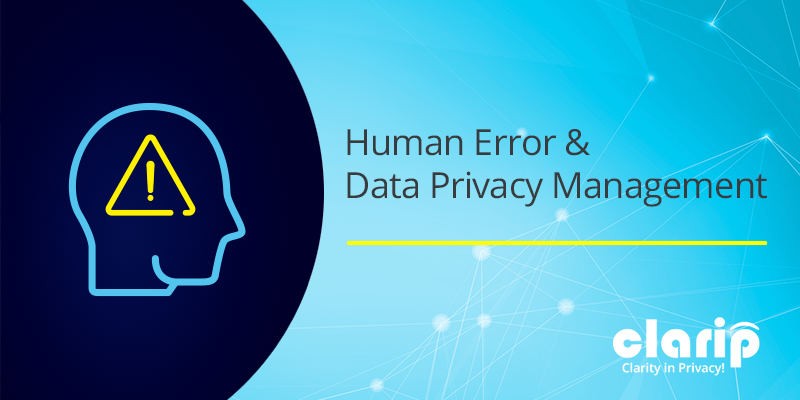Human Error & Data Privacy Management

All large consumer services organization should have a well-established data governance and data privacy management team, directors, and/or officers (DPOs, CPOs, CISOs, etc.). Data privacy management involves various processes, including data classification, data access control, data retention and disposal, and data breach management. Without automation, much of this is handled with hundreds of spreadsheets, surveys, and substantial lost hours scouring and replying to emails. However, data privacy management is not immune to human error, which can result in significant privacy breaches and legal consequences for organizations.
Data Breaches Due to Human Error
One of the primary concerns about human error in data privacy management is the potential for accidental data breaches. A member of a privacy team might accidentally send an email containing sensitive data to the wrong recipient or fail to redact confidential information in a document. Such errors can lead to unauthorized access, disclosure, or loss of sensitive information, which can have severe consequences for individuals and organizations.
Manual Data Mapping and Human Error
Data mapping is the process of translating data from one format or system to another, often in order to integrate or consolidate data from different sources. While data mapping is a powerful tool for businesses and organizations, the potential for human error is high when preformed manually.
One of the main concerns with data mapping is that it can be a complex and time-consuming process, increasing the risk of mistakes. Mapping data between different systems requires a high level of accuracy, and even small errors can have significant consequences. If data is mapped incorrectly, it could lead to inaccurate reporting, poor decision-making, or even legal and compliance issues.
Another concern is that data mapping can be highly technical, and not all employees may have the necessary skills or experience to perform it correctly. This can lead to errors or inconsistencies in the mapping process, which can then cascade throughout the organization’s data ecosystem.
To mitigate these risks, organizations can take several steps.
- Establish clear data mapping protocols and procedures, with standardized tools and templates.
- Invest in training and development programs to ensure that employees have the necessary skills and knowledge to perform data mapping accurately.
- Regular testing and quality assurance checks can help catch errors before they cause problems.
- Implement automated data mapping tools that help reduce risks and take the guess work out.
Data Subject Rights Requests and Human Error
Data subject Rights Requests (DSRRs) are a critical part of consumer rights and privacy regulations like the General Data Protection Regulation (GDPR), the California Consumer Privacy Act (CCPA), the Virginia Consumer Data Protection Act, and other emerging privacy laws. These requests give individuals the right to access, correct, transfer or delete their personal data held by an organization.
However, there are serious concerns about the potential for human error in handling DSRRs. By using a manual email approach, a team member might accidentally disclose the personal data of an individual to someone who is not authorized to see it. Poor data mapping practices can lead to incorrect or partial access requests, partial delete requests, and misleading privacy practices when an audit occurs. Alternatively, a staff member might delete the wrong data or fail to respond to a data subject in a timely manner. Negligence like these can lead to significant legal actions, fines, or other penalties. Therefore, it is essential that organizations have robust processes and tools in place to manage DSRRs and minimize the risk of human error.
Opt-Out (DNSS) and Human Error
Opt-out, or Do Not Sell/Share, provides consumers a method to opt-out of marketing communications or to limit the use of their personal data for marketing purposes. However, a team member might accidentally send marketing communications to someone who has opted-out, or they might fail to update the individual’s preferences correctly in the organization’s systems. Without proper DNSS tools, like tracking and automation, team members might not be aware of the opt-out request, resulting in continued marketing communications to the individual. This will lead to dissatisfaction, frustration, and reduced trust for the consumer.
Conclusion: Reduce Human Error with Automation
Human error is a serious concern in data privacy management and can result in significant financial and legal consequences for organizations. Implementing automated data mapping with Clarip’s patented auto-tagging and categorization technologies, organizations can take the guess work out of the data minimization scenarios. Clarip takes data privacy governance to the next level and helps organizations reduce risks, engage better, and gain customers’ trust!
Contact us at www.clarip.com or call Clarip at 1-888-252-5653 for a demo.
Email Now:
Mike Mango, VP of Sales
mmango@clarip.com
Related Content:
Making the Case for Data Minimization
Automated Data Mapping
Data Discovery
Looking for Product Data Sheets?

 Data Risk Intelligence
Data Risk Intelligence Automated Data Mapping
Automated Data Mapping Do Not Sell/Do Not Share
Do Not Sell/Do Not Share Cookie Banner Solutions
Cookie Banner Solutions Consent & Preferences
Consent & Preferences Data Rights Requests
Data Rights Requests
